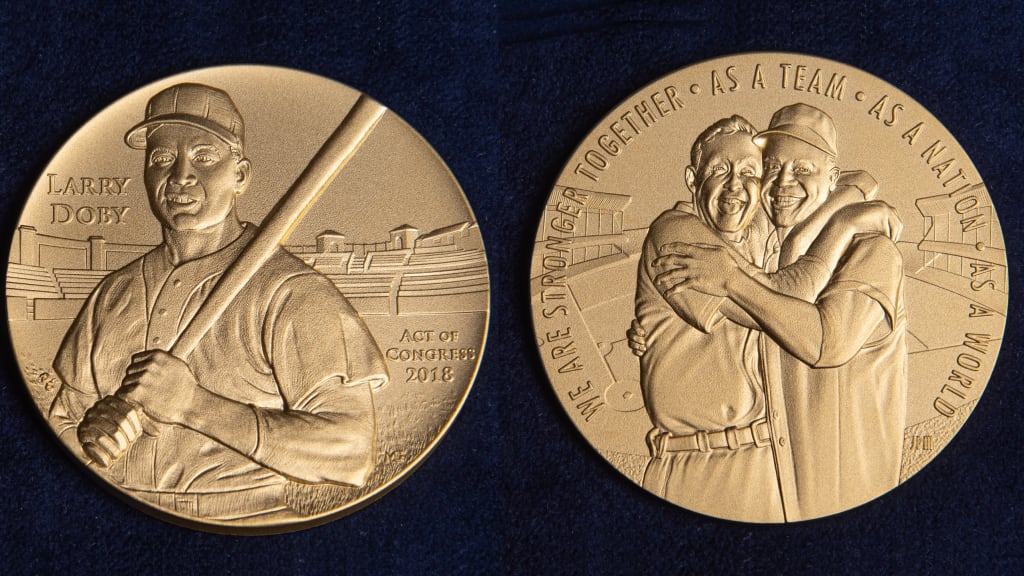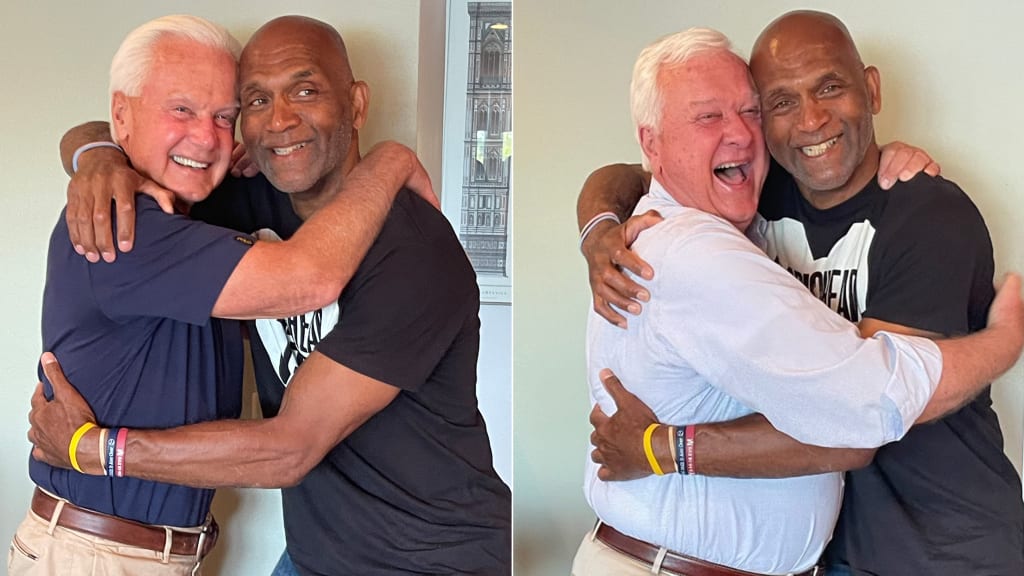The United States Mint was unaccustomed to requests like the one made by Larry Doby Jr.
For centuries, the bureau of the Department of the Treasury has been responsible for designing and casting the Congressional Gold Medal -- the highest civilian honor in the country. And as part of that process, the Mint’s team of artists will typically consult with recipients or their surviving family members to determine the proper way to present the individual’s achievements and contributions.
But after Congress voted to posthumously award Larry Doby -- a World War II veteran, Negro Leagues star and the first Black player in the American League -- with a Congressional Gold Medal back in 2018, this process hit a snag.
Because Doby Jr. didn’t just want his father on the coin.
He wanted another man on it, too.
“I was told [by the Mint] right away,” Doby Jr. said, “that that’s not what they do.”
The Mint is not in the habit of emblazoning images of people who aren’t being saluted on these precious medals. Yet Doby Jr. was adamant that the image he requested for the back of the medal was too important to be denied.
If you watch “Stronger Together,” MLB Network’s new feature on Doby’s Congressional Gold Medal, you’ll see that he was right.
The feature tells the story of a photo taken in the home clubhouse at Cleveland’s Municipal Stadium on Oct. 9, 1948.
That afternoon, in front of more than 80,000 fans, Larry Doby hit the go-ahead home run and a right-hander named Steve Gromek threw a complete game in a 2-1 victory that gave the Indians a commanding lead in a World Series they would go on to win.
In the aftermath, Doby and Gromek embraced, cheek-to-cheek, in front of Gromek’s locker. A Cleveland Plain Dealer photographer snapped the image of the two triumphant teammates, and The Associated Press transmitted it to newspapers across the country. Americans saw a Black man and a white man brandishing big smiles, blissfully unbound by the widespread racial discrimination and segregation of the time.

Some celebrated the photo; many others reflexively cringed.
When Gromek returned home to Hamtramck, Mich., that offseason, he was given the cold shoulder by supposed friends who were angry with him for taking such a photo with a Black man.
“He said that people were put off by it, so they would not engage him in conversation if they bumped into him,” Gromek’s son Carl said of his dad, who passed away in 2002. “But I think my dad looked at it like, ‘They've got a problem, I don't have a problem.’ He cherished that picture.”
So did Doby. He once called it the best moment of his baseball career.
“That is the first time that I can recall -- or many people can recall -- that a Black and a white embraced each other in that fashion, [and it] went all over the world,” said Doby, who passed away in 2003. “That picture just showed to me the feelings that you have. You don’t think about it in terms of color. It’s a feeling you have for a person.”
During the Congressional Gold Medal design process, which typically takes about 18 months even when without holdups, Doby Jr. kept thinking about that photo: What it meant to his dad, what it represented in 1948, and what it represents today.
“It’s everything that we should be,” Doby Jr. said. “United, common goal, stronger together.”
Though the Mint’s pushback was an early complication, it was not a lasting one. Doby Jr. was persistent and insistent, even enlisting the help of Rep. Bill Pascrell (D-NJ), who had sponsored the bill that awarded the medal to Doby.
“I guess I dug my heels in a little bit,” Doby Jr. said.
The bureau eventually relented to create what Mint Director Ventris C. Gibson called a “unique” design on the back of Doby’s medal.
“It’s a beautiful image, a milestone image,” said Mint medallic artist John McGraw, the designer of the medal. “It’s also a celebration of Larry Doby being the first Black man to hit a homer in the World Series. To me, as a big baseball fan, I think it’s one of the most important milestones we have in baseball.”

For the front of Doby’s medal, McGraw depicted Doby in Hinchliffe Stadium, the recently restored Paterson, N.J., facility where he starred in high school baseball and football and first tried out for the Negro National League’s Newark Eagles.
That part was straightforward.
The challenge with the back was replicating a specific picture that is familiar to so many.
“The image was so clear and concise,” said McGraw, “that you just wanted to make sure that you captured their facial structure and the impressions that they had and the smiles in that moment.”
McGraw had to make one change to the original photo by moving Doby’s left hand down slightly so that both men’s faces could be seen clearly. Other than that, the iconic moment is perfectly preserved in gold.
“You can see the apprenticeship and feel the warmth through the depiction on the gold medal,” Gibson said. “It’s something that people will treasure forever.”
Doby Jr. chose the words for the inscription: “We are stronger together as a team, as a nation, as a world.”
After long delays due to the design complications, the pandemic and Congressional distractions, the Doby family was finally presented with the finished product in a touching ceremony in the Statuary Hall at the U.S. Capitol on Dec. 13, 2023 -- on what would have been Larry Doby’s 100th birthday.
That ceremony was meaningful not just to the Doby family but also to the Gromeks. Carl and his brother, Greg, drove to D.C. with their 98-year-old mother, Jeanette.
“We drove 12 hours, because she couldn’t fly,” Carl said that day. “So we made a big trip. She wasn’t going to miss this.”
Doby Jr. had reached out to the Gromek family to get their approval for using the image on the medal. He called Carl, who happened to be in his home office where the photo hangs framed and signed by both his dad and Doby. Carl of course said yes. Later, when Doby Jr., a member of musician Billy Joel’s road crew, was working at Comerica Park for a 2022 concert, he was invited to Carl’s Detroit-area home for a family dinner.
“He comes to the house, he sees the rest of the family and says, ‘Where’s the queen?’” Carl said. “Well, my mother fell in love with him.”
After sharing a meal and some memories, somebody had the idea of recreating the image. And so Doby Jr. posed with each of the Gromek brothers, with Greg doing an especially fine job of capturing his dad’s contagiously cheerful countenance.

No smile, however, was bigger than that of Jeanette when she got to hold the medal after the ceremony in D.C. She had lost her vision with age, but she was able to feel the texture of her late husband’s image next to that of Larry Doby.
She was beaming.
“She’ll take that to the grave,” Carl said through tears. “So special, so special. … My mother hasn’t smiled like that in a long time. Probably the last time was when we had Larry over for dinner.”
That moment took on greater poignancy this week, when Jeanette Gromek passed away, shortly after celebrating her 99th birthday. Losing her just two months after the ceremony made her family even more grateful for the medal.
Like the two men in that famous photo, the Doby and Gromek families are now forever intertwined. And thanks to the memento produced by the Mint, a powerful image of unity and teamwork is forever etched in gold.
“I am very happy that we are linked,” Doby Jr. says. “Because that picture says a thousand words. And they’re a thousand damn good words.”
